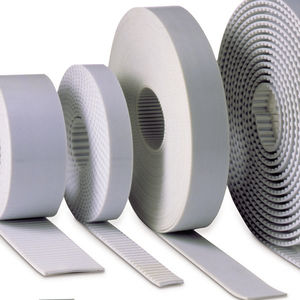
- Company
- Products
- Catalogs
- News & Trends
- Exhibitions
Toothed belt Megalinear QSTtrapezoidalpolyurethanepulley


Add to favorites
Compare this product
Characteristics
- Type
- toothed, trapezoidal
- Material
- polyurethane
- Product applications
- pulley, positioning, for lifting applications
- Sector
- industrial
- Other characteristics
- high wear resistance, coated
Description
Megadyne has expanded its range of synchronous polyurethane products with the new MEGALINEAR Quiet Self Track (QST).
The precise and continuous mesh between belt and pulley delivers an improved reduction in noise level, versus traditional types of trapezoidal and curvilinear tooth designs.
Additionally, MEGALINEAR QST products are self-tracking, eliminating the need for flanged pulleys.
MEGALINEAR QST
PLAY
Features
The Offset Tooth design allows MEGALINEAR QST to run more quietly than any other synchronous product. MEGALINEAR QST shows a significant reduction of dB (A) in the applications where traditional timing belt tooth profiles are used.
MEGALINEAR QST design consists of left and right Offset Teeth which guides the belt into the centre of the QST pulley, eliminating any belt wander and ensuring high precision linear positioning. The self-tracking nature of the offset teeth eliminates the need for pulley flanges.
MAIN COMPONENTS
01 / BODY
The body of the belt is made with thermoplastic polyurethane 92 ShA.
02 / CORD
High strength zinc coated steel tension members (S and Z torsion).
03 / COVER
Standard tooth cover in NFT.
Compatible for fabrication with other thermoplastic materials.
Timing belts Polyurethane open end MEGALINEAR QST
MECHANICAL AND CHEMICAL PROPERTIES
high torque capacity
good resistance to ageing, hydrolysis, U.V.A., ozone, most acids and alkalis
greater belt life
good resistance to oils, grease and fat
MEGALINEAR QST belt working temperature -25°C/+80°C
VIDEO
Catalogs
QST system product brochure
8 Pages
MEGADYNE PRODUCTS GUIDE
86 Pages
Related Searches
- MEGADYNE transmission belt
- MEGADYNE industrial belt
- MEGADYNE rubber belt
- Rigid shaft coupling
- MEGADYNE plastic belt
- MEGADYNE toothed belt
- Sleeve shaft coupling
- Industrial belt
- MEGADYNE sturdy belt
- MEGADYNE polyurethane belt
- MEGADYNE synchronous belt
- Flat strip
- MEGADYNE oil-resistant belt
- Toothed pulley
- MEGADYNE trapezoidal belt
- Flexible belt
- MEGADYNE high-performance belt
- Pulley power transmission belt
- MEGADYNE high-resistance belt
- MEGADYNE abrasion-resistant belt
*Prices are pre-tax. They exclude delivery charges and customs duties and do not include additional charges for installation or activation options. Prices are indicative only and may vary by country, with changes to the cost of raw materials and exchange rates.













